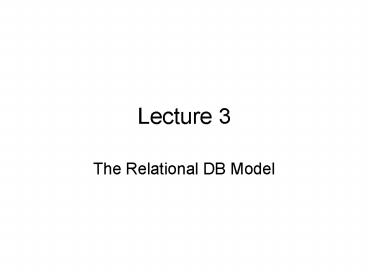The Relational DB Model - PowerPoint PPT Presentation
Title:
The Relational DB Model
Description:
Lecture 3 The Relational DB Model – PowerPoint PPT presentation
Number of Views:68
Avg rating:3.0/5.0
Title: The Relational DB Model
1
Lecture 3
- The Relational DB Model
2
Learning Objectives
- That the relational database model takes a
logical view of data - That the relational models basic components are
entities, attributes, and relationships among
entities - How entities and their attributes are organized
into tables - About relational database operators, the data
dictionary, and the system catalog - How data redundancy is handled in the relational
database model - Why indexing is important
3
Oracle log on procedures
- Can log from home
- Download putty shell
http//www.chiark.greenend.org.uk/sgtatham/putty/
download.html
4
Two steps
- Log on to UNIX
- Log on to ORACLE
- To change ORACLE Password
- Sqlgt ALTER USER username IDENTIFIED BY
newpassword
5
- to get information on your table
- sqlgt DESC tablename
- to get a list of your tables
- Sqlgt SELECT TABLE_NAME FROM USER_TABLES
- To save
- Sqlgt commit
- To unsave
- Sqlgt rollback
6
Scope of SQL
- DDL statements
- SqlgtCreate
- SqlgtDrop
- SqlgtAlter
- DML statements
- SqlgtSelect
- SqlgtUpdate
- SqlgtDelete
- SqlgtInsert
7
Creating DB Structure
- Steps
- create SCHEMA
- (already done for you)
- create TABLES
- FK PK
- create VIEWS
- create indexes
8
Relational table
- Two Dim structure
- Order of rows is NOT important
- Cols represent attributes
- Row represent an occurrence of an entity
- Each column has a set of allowable values, called
domain - Each table has a primary key
- Intersection of row/column represent a single
value
9
Data Structure Data Types
- Data Structure
- Domain
- Relationship
- relational DB
- Keys (PK FK)
- Data Type
- Numeric/Character
- Date
- Logical
- Pictures
- Graphical
10
Relation
- Relation is a table of n columns and m rows.,
Referred to as m x n - rows define CARDINALITY (m), cols define DEGREE
(n) - relations are represented as
- relation (attribute names..)
- ex
- STUDENT (student name, student ss, student
address, GPA)
11
Relational DB
- a collection of relations
- Keys
- Primary
- Candidate
- Foreign
- Secondary
12
Primary Key (PK) (page 66)
- a unique identifier guarantees that each row of a
relation can be uniquely addressed, in other
words, if I give you the value of a primary key
,we should get one and only one tuple (row) from
the table. It is usually a field from the table
or a combination of fields (also called
concatenated or composite key) from the table.
13
PK for a Bank
- CUSTOMER (CUST_ID, ACCT_ID, ACCT_BALANCE)
14
Foreign key
- Relates two tables
- An attribute in ONE table which relates PK in
another table - Candidate key
- Secondary key
15
Functional dependency
- A--? B
- (A , B)--? C
16
Integrity Rules
- Entity integrity
- Referential integrity
17
Relational Algebra (p 72 p298)
- Union compatible
- Operations
- Union
- Difference
- Intersect
18
Relationship among databases
- 11
- 1m
- Mn
- recursive
19
ER Diagrams and their conversion to relations
- 11
- 1m
- Mn
20
The Data Dictionary and System Catalog (page 78)
- Data dictionary
- Used to provide detailed accounting of all tables
found within the user/designer-created database - Contains (at least) all the attribute names and
characteristics for each table in the system - Contains metadatadata about data
- Sometimes described as the database designers
database because it records the design decisions
about tables and their structures
21
The Data Dictionary and the System Catalog
(continued)
- System catalog
- Contains metadata
- Detailed system data dictionary that describes
all objects within the database - Terms system catalog and data dictionary are
often used interchangeably - Can be queried just like any user/designer-created
table
22
Indexes
- Unique
- Non-unique
- Index points to the records in the table
23
- Q1,4, 5 and 6/p96

